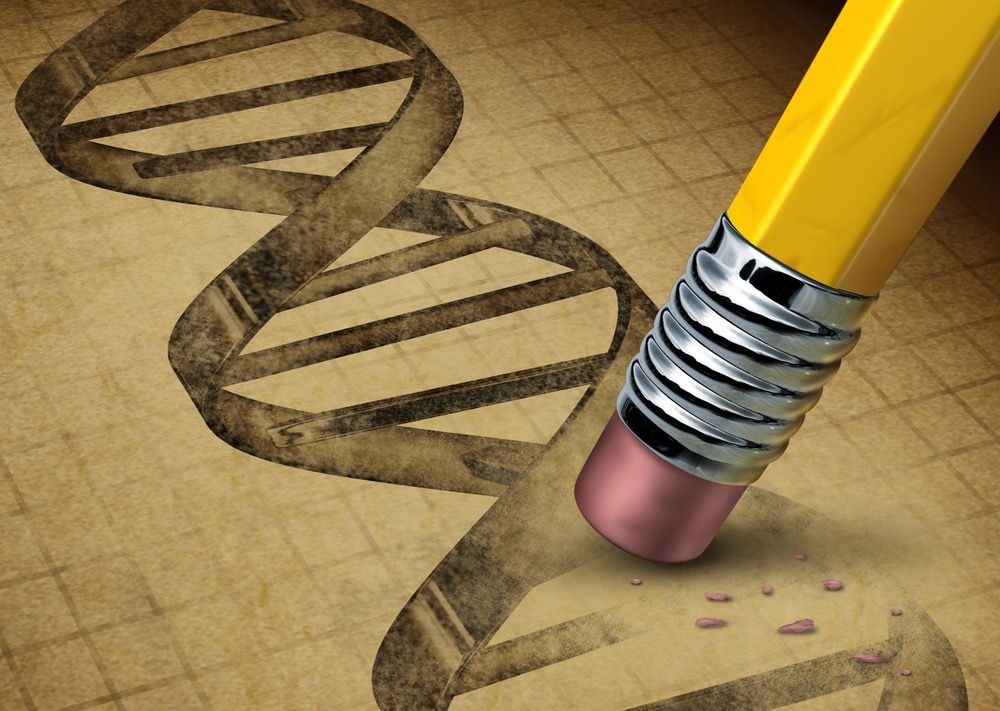
Did Harvard Scientists Secretly Discuss Making a Human from Scratch?

Did you hear about the secret meeting earlier this month at Harvard Medical School? The one where scientists schemed to create a parentless human being from scratch? Maybe you read one of the skeptical news articles, or the stories illustrated with images from the dystopian sci-fi classic “Blade Runner” or of a robot Frankenstein. One blogger compared the meeting to a gathering of “Bond villains.”
The press coverage was suspicious and critical. Why would a bunch of scientists need to exclude the media and the public from a meeting about something as ethically fraught as synthesizing a human genome?
Three weeks later, the exact details of what happened are still being contested. I’m a researcher in synthetic biology, and I learned of the project from reading the newspaper. I reached out to the meeting’s organizers, who – for reasons I’ll explain – declined to comment for this article. But in conversations with meeting invitees, as well as some critics, I’ve found that much of the press coverage was misleading, and says more about the relationship between journalists and scientists than the meeting itself.
What really happened behind closed doors when over 130 scientists, industry leaders and ethicists convened to talk about synthesizing a human genome? How did these sessions end up so widely misunderstood by the media and the public?
Open doors versus science publishing protocols
The May 10 meeting was titled “HGP-Write: Testing Large Synthetic Genomes in Cells.” HGP refers to the Human Genome Project, the world’s largest collaborative biological effort that resulted in the sequencing of the full human genome in 2003.
Those invited say the organizers hoped to inspire scientists and the public with a new grand challenge project: to advance from reading genomes to writing them, by manufacturing them from individual DNA building blocks. In an invitation dated March 30, the hosts proposed a bold collaborative effort to “synthesize a complete human genome within a cell line.” Panels tackled whether such an effort is worthwhile, as well as the ethical, technological and economic challenges.
The conversation was not intended to be restricted. The meeting organizers – Harvard geneticist George Church; New York University systems geneticist Jef Boeke; Andrew Hessel, of the Bio/Nano research group at Autodesk, Inc.; and Nancy J. Kelley, a lawyer specializing in biotechnology consulting – had plans to engage the broader scientific community, as well as industry, policy makers and the public. They made a video recording of the entire meeting, originally intended to be live-streamed over the Internet. They planned to apply for federal funding, which would invite regulatory oversight. And they submitted a white paper to a major peer-reviewed journal explaining the scientific, technological and ethical aspects of the project.
Sign up for the Live Science daily newsletter now
Get the world’s most fascinating discoveries delivered straight to your inbox.
But the publication of the paper was delayed – the authors haven’t disclosed why, although editors commonly ask for revisions as part of the peer review process. (As of this writing, it has not yet come out.) The organizers are prohibited from discussing the paper in public until it is published – a common journal policy known as an embargo. In deference to the embargo, they declined to comment in detail for this article.
News of the delay came just days before the meeting, and, with dozens of attendees en route, the hosts made a fateful decision. They chose to proceed, but to close the doors to most journalists and ask attendees to delay public discussion until the embargo lifts. (At least one journalist was there – Simone Ross, co-founder of Techonomy Media, confirmed her attendance to me.) “I’m not sure that was the best idea,” Dr. Church told STAT News of the decision to proceed out of the public eye.
The secrecy bred suspicion. “Would it be OK to sequence and then synthesize Einstein’s genome?” asked Stanford bioengineer Drew Endy and Northwestern bioethicist Laurie Zoloth in a joint essay. In theory, an artificial human genome could be used to generate a living human without biological parents. “This idea is an enormous step for the human species, and it shouldn’t be discussed only behind closed doors,” STAT News quoted Dr. Zoloth.
Beyond qualms about the science itself, some observers were concerned that the organizers' decisions - which included seeking industry partners and private funding - were quiet moves towards “privatiz[ing] the current conversation about heritable genetic modification.”
The mundane truth about synthetic DNA
But whether or not the meeting was truly secret is a distraction from its declared main purpose – to discuss the future of DNA synthesis.
The process of making artificial DNA is similar to letterpress printing – each character is painstakingly assembled in the correct order. The result is chemically identical to naturally-occurring DNA. The global market for synthetic DNA is estimated at nearly US$1 billion annually, and does not typically draw much ethical scrutiny. Indeed, both Drs. Church and Endy are co-founders of a DNA synthesis company called Gen9.
Synthetic DNA is behind promising treatments for cancer, heart disease, HIV and Alzheimer’s disease. In their invitation, meeting organizers expressed hope that the project would enable “the development of safer, less costly and more effective therapeutics.” Customized cells could be designed to produce biofuels, clean up pollution, or halt the spread of pandemics. Additionally, scientists know that small changes to one’s DNA can majorly influence health, but they have a limited set of tools to study these changes in detail.
The press has largely cheered recent advances in synthesizing DNA. In 2010, J. Craig Venter and his team fabricated all 1 million bases of a bacterial genome and transplanted it into a cell. In 2014, meeting organizer Dr. Boeke accomplished the same with one of the 16 yeast chromosomes; he currently leads a consortium trying to synthesize the rest. And the goal of synthesizing a human genome is not new - Mr. Hessel, another organizer, stated his interest in doing so as early as 2012.
And while undoubtedly controversial, meeting conveners say the proposal to make a human genome was intended to inspire a unified vision for the future of synthetic biology, and a plan for addressing the current barriers.
For example, even the genome of a tiny microbe proved to be a steep and costly challenge for Dr. Venter and his team. Creating the synthetic bacterium cost over $40 million and required years of work. At current prices, a single human genome would cost $90 million to manufacture – though Dr. Endy predicts that as costs continue to decline, the price tag could drop to $100,000 by 2036.
There is also the issue of manufacturing capacity. Currently, the entire yearly global production of synthetic DNA would not be enough to print a single human genome.
A major focus of the meeting, say numerous attendees, was to begin to address these technical shortcomings.
Ethical debate in advance
Much of the suspicion around the meeting focused on the idea that researchers were hatching clandestine plans to clone human beings via synthetic DNA. And chemically manufacturing the human genome - the set of genetic instructions found in every cell - would truly give new meaning to the term “test-tube baby.” If such a technology existed, any individual’s genome could be decoded and then synthesized on demand by anyone with the know-how.
Ethicists and the news media blew the whistle on what looked to them like scientific hubris.
In their essay, Drs. Endy and Zoloth argue that synthesizing life is “an enormous moral gesture” which should not be undertaken lightly. And they worry that linking the future of synthetic biology to such a controversial stated goal could jeopardize the entire endeavor.
It makes sense to wrestle with ethical questions well in advance of being confronted with immediate, real-world applications. But at the moment, I’d argue human cloning remains a distant dream.
Importantly, there’s currently no way to transplant an artificial genome into human cells, and even the most impressive achievements - like Dr. Boeke’s yeast project - are hundreds of times smaller in scale than the proposed challenge. It’s not even clear that making a synthetic human cell is worth it. Fabricating the genome of a fruit fly or nematode - 30 times smaller and less ethically fraught than that of a person - could answer many of the same questions.
Scientists could also study human genetics by analyzing people whose DNA already contains the desired features, or by using tools to edit existing DNA.
Science/journalism symbiosis
Apart from the scientific questions, the episode highlights the complicated relationship between scientists and the journalists who cover their work. It’s a necessary partnership but one with more than a hint of distrust in both directions.
In a lemons-out-of-lemonade email sent to invitees after the embargo prompted them to close the event to journalists and the public, conference organizers wrote they hoped the decision would allow attendees to “speak freely and candidly without concerns about being misquoted or misinterpreted” – though apparently that wasn’t enough of a concern for them to bar media from the get-go.
The organizers of the meeting are surely not blameless for the public reception. The decision to respect the embargo was interpreted by the press as suspicious. If one goal of the meeting was to provoke, can the media be blamed for taking notice? And if the meeting was held in private, then isn’t it natural to ask what those in attendance have to hide?
The episode also points to an emerging conflict between social media and traditional science publishing. Research journals move at a glacial pace; nearly all of my colleagues have at at one point waited six months or more to publish. Will the long publication cycle and the normally obscure embargo policy be able to adjust to an era when scientific discussions happen at the speed of Twitter?
Researchers must rely on journalists for their communication skills and the audience they reach. And journalists will play a crucial role in facilitating the ethical discussion around synthetic biology – one whose stakeholders include scientists as well as ethicists, policy makers and the broader public – and what the goals and action items of such a debate will be. Critically, a balance must be struck between the watchdog role of the press and the legitimate needs of any profession to carry out some of their discussions in private.
Jeff Bessen, PhD Candidate in Chemical Biology, Harvard University
This article was originally published on The Conversation. Read the original article.



